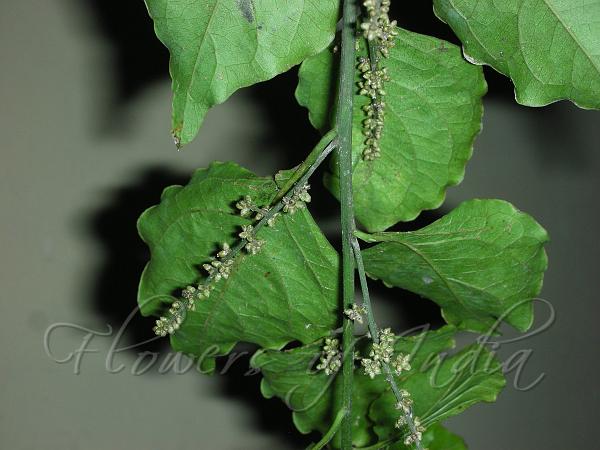|
| Himalayan Bosea |
|

|

| File size | 875391 |
| Original date | 7/4/08 3:28 AM |
| Resolution | 2816 x 2112 |
| Flash | Flash fired |
| Focal length | 12.2mm |
| Exposure time | 1/120s |
| Aperture | 12.4 |
| Focus Distance | |
| Metering Mode | Multi-segment |
| Camera make | NIKON |
| Camera model | COOLPIX S6 |
| Sensor type |
|
|
|
|
Photo: |
Botanical name: Bosea amherstiana Family: Amaranthaceae (Amaranth family)
Synonyms: Rodetia amherstiana
Synonyms: Rodetia amherstiana
Himalayan Bosea is a large, much-branched,
straggling shrub up to at least 3.5 m tall, with elongated branches.
Stem and branches are hairless, round, yellowish-green to
purplish-suffused. Leaves are hairless, broadly ovate to
lanceshaped-ovate, pointed to long-pointed, 3-12.5 x 1.5-8 cm, stalk
4-15 mm. ZTiny flowers are borne in spikes in leaf axils or at branch
ends. The ones at branch ends are usually panicule-like. Bracts in the
lower part of the inflorescence lanceolate, acute, about 1 mm, becoming
broader, shorter and blunter above; bracteoles are usually 4, the inner
deltoid-suborbicular, obtuse, pale-margined, 0.75-1.25 mm, the outer
shorter and smaller. Flowers are hermaphrodite, stalkless, solitary or
in few-flowered clusters, very numerous. Tepals are orbicular-oval,
2-2.5 mm, greenish with broad, white margins, with a long central nerve
and 2-4 shorter lateral nerves, glabrous. Filaments are slender, about
1.5 times as long as the perianth. Stigmas about 0.5 mm, erect or
spreading, stout, style very short; ovary ovoid. Berry is globose,
bright red, 4 mm. Seed black, shining, minutely rugulose, broadly
kidney-shaed. about 2.5 mm. Himalayan Bosea was named for Countess
Amherst, wife of Lord Amherst, Governor of Burma and India in the early
19th century. Himalayan Bosea is found in NW Himalayas, at altitudes of
900-2000 m.
| Identification credit: Krishan Lal | Photographed in Sirmaur Distt, Himachal Pradesh. |
• Is this flower misidentified? If yes,